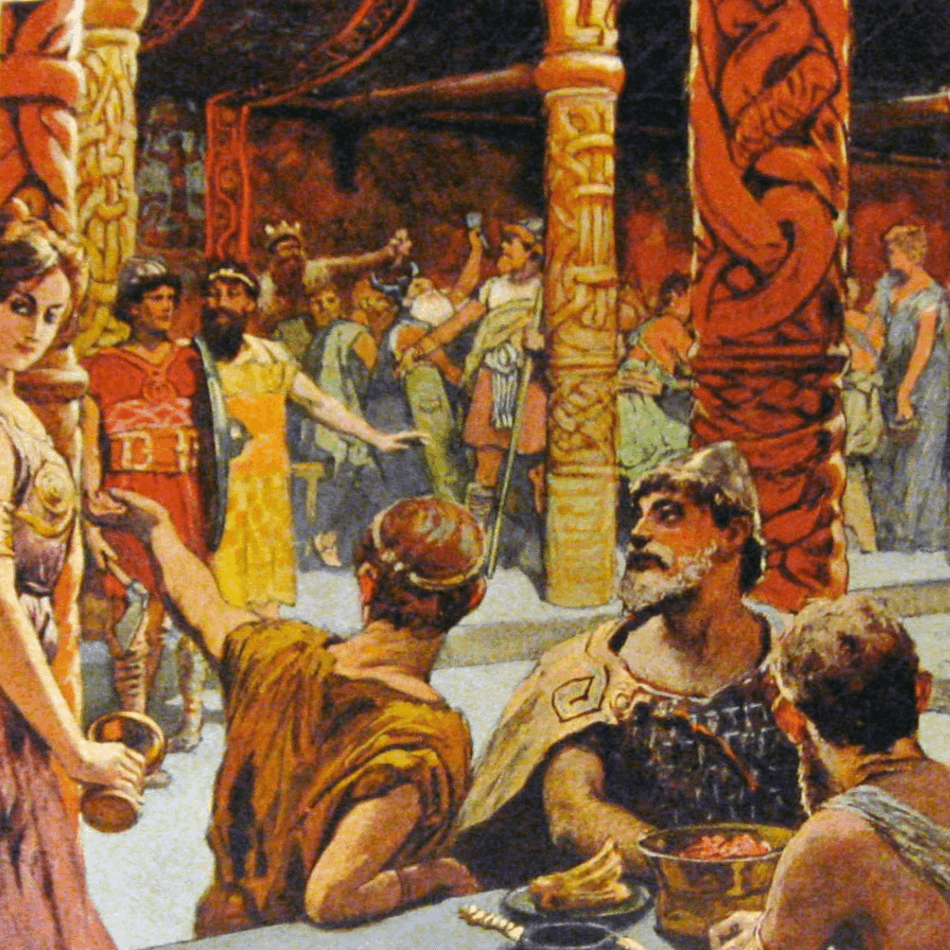Viking Drakkars: The Mighty Legends of the Norse Seas
When one thinks of the fearless Vikings and their awe-inspiring seafaring adventures, images of their magnificent longships, known as drakkars, come to mind. These iconic vessels played a crucial role in the Viking Age, enabling the Norsemen to embark on ambitious voyages, conduct raids, and establish new territories across Europe. In this blog post, we delve into the world of Viking drakkars, exploring their design, historical significance, and enduring legacy.

Design of a Drakkar
Viking drakkars were remarkable in both form and function. These longships were meticulously crafted, designed to navigate rough seas, shallow rivers, and even cross vast open waters. They were built with a shallow draft, allowing them to sail through narrow waterways and conduct surprise raids on unsuspecting coastal towns.
Drakkars were clinker-built, a construction technique that involved overlapping planks riveted together with iron nails. This method provided strength, flexibility, and ensured the ship's ability to withstand the harsh conditions of the sea. The vessels featured a keel and a sternpost, allowing for stability and maneuverability.
These longships were powered by both sails and oars, granting the Vikings remarkable speed and agility on the water. The square or rectangular sails, made of wool or linen, were hoisted on a mast that could be raised or lowered as needed. The oars were crucial for maneuvering in narrow or crowded waters, allowing the Vikings to swiftly change direction or execute surprise attacks.
These vessels were also known for their exceptional speed, often capable of reaching impressive velocities. Their shallow drafts allowed them to travel far inland, making them formidable opponents in both coastal raids and inland warfare.
The prow, or the front of a Viking drakkar, often featured a distinctive figurehead known as a nasal figure. These figureheads were intricately carved sculptures mounted at the bow of the ship, typically representing mythical creatures, animals, or powerful Viking deities. The purpose of these figureheads was not only decorative but also symbolic, as they were believed to provide protection and guidance to the ship and its crew during their seafaring expeditions.
The drakkar nasal figures were often fierce and intimidating, reflecting the Viking's warrior culture and their desire to strike fear into their adversaries. Some popular motifs for these figureheads included dragons, serpents, wolves, ravens, and other creatures of Norse mythology. These figures were often adorned with intricate details, such as sharp teeth, piercing eyes, and elaborate carvings, showcasing the craftsmanship and artistic skills of the Viking artisans.
In addition to their symbolic significance, drakkar nasal figures also served practical purposes. The extended shape of the figurehead helped to improve the ship's maneuverability by reducing the resistance of the water, enabling the drakkar to navigate through rough seas more effectively.
The drakkar nasal figures were not only an essential part of the ship's design but also a reflection of the Viking culture and their beliefs. They added a distinct and fearsome character to the drakkar, making it an imposing sight on the open waters.
Viking Expansion
The Viking drakkars were not mere vessels of transportation; they were the catalysts for Viking expansion and exploration. These ships enabled the Vikings to undertake daring journeys, navigate treacherous waters, and establish settlements in far-off lands. With their maritime prowess, the Vikings were able to colonize areas such as Iceland, Greenland, and even reach as far as North America, nearly 500 years before Columbus.
The presence of Vikings in Australia is also a subject of ongoing debate among historians and archaeologists. While there is no concrete evidence of widespread Viking settlements or long-term colonization in Australia, there are intriguing indications of potential Viking contact with the continent. Norse sagas and historical accounts mention a land known as "Hvitramannaland" or "Great Ireland," which some scholars speculate could refer to Australia. Additionally, a few archaeological discoveries, speculated to be Viking-era artifacts found in Western Australia, have sparked discussion about possible Viking visits to this continent.
The drakkars were also instrumental in Viking raids, commonly associated with the Viking Age. These swift and stealthy ships allowed the Norsemen to strike quickly and disappear before their victims had a chance to mount a proper defense. The sight of a drakkar on the horizon struck fear into the hearts of coastal communities, as it meant imminent danger and potential plunder.
Who Owned the Drakkars?
Viking drakkars were owned by individual Viking chieftains, wealthy landowners, or prominent leaders within Viking society. These individuals would commission the construction of the ships and assume ownership of them. Vikings were known for their maritime culture, and owning a drakkar was a symbol of status, wealth, and power.
It is important to note that not every Viking had their own drakkar. Smaller, less wealthy Viking communities or individuals might have relied on communal ships or smaller boats for their sea voyages. However, the larger and more elaborate drakkars were typically associated with the elite members of Viking society.

Drakkars were considered valuable assets and were often passed down through generations within a family. They were not only used for raiding and exploration, but also for trade and transportation. These ships played a significant role in the economic and social activities of the Vikings, further enhancing the status of their owners.
While the ownership of drakkars was concentrated among the Viking elite, it is important to acknowledge that Vikings had a diverse range of ships that served different purposes. Not every Viking ship was a drakkar, and there were variations in size, design, and ownership depending on the specific needs and resources of different Viking communities.
However, the Viking drakkars themselves left an indelible mark on history, symbolizing the might and adventurous spirit of the Norse seafarers. Today, replicas of these legendary ships can be found in museums, serving as reminders of the Vikings' extraordinary maritime achievements.
Moreover, the drakkar's influence extends beyond the realm of seafaring. The iconic dragon-head prow, often carved with intricate detail, has become an enduring symbol of Viking heritage. It represents the fearsome persona of the Vikings, striking fear into their enemies while showcasing their artistry and craftsmanship.
The Viking drakkars were more than just vessels; they were the keys to Norse exploration, colonization, and conquest during the Viking Age. These awe-inspiring ships, with their sleek design, formidable power, and rich historical significance, continue to capture our imagination and stand as a testament to the Vikings' extraordinary achievements. The legacy of the drakkars and the seafaring spirit of the Vikings will forever be remembered as a remarkable chapter in human history.


